At a Publishers Advertising and Marketing Association luncheon yesterday, EarlyWord.com editor and co-founder Nora Rawlinson moderated a panel called "Secrets of the Librarians: How to Create Demand for Your Books." She began by outlining the scope of the U.S. public library ecosystem--roughly 9,000 library systems, the vast majority of which have three or fewer branches. Only 70 library systems nationwide have 20 or more branches; five of the top six are based in New York City or the greater Los Angeles area. She also explained that many libraries are taking lessons from bookstore displays and other promotional techniques to inform their patrons about titles they've gotten behind, and used a Baltimore-area library's enthusiasm for Kate Alcott's The Dressmaker as an example.
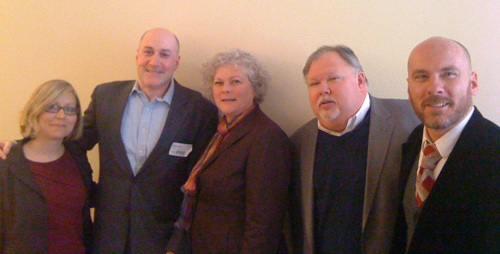 |
| Andrea Vaughn Johnson, PAMA president David Nudo, Nora Rawlinson, Skip Dye, Chris Platt. |
Skip Dye, Random House v-p, director of library and academic sales, picked up on that thread, after noting how ironic it was given that, in his previous role at the Davis-Kidd bookstores, "we did everything we could to get people into the store by mimicking libraries," including holding story hours and other in-store programming. A recent tour of several libraries taught him about the renewed enthusiasm for displays but, given that libraries are all about getting the books off the shelves and into people's hands, it's hard to use books effectively in displays. Instead, libraries are interested in cutouts and other display materials that, he noted, publishers had been cutting back on producing for bookstore markets.
Chris Platt, the director of collection and circulation operations for the New York Public Library, focused on his institution's online efforts, especially the goal of making the NYPL website the "intellectual home" for its patrons. In that framework, he explained, "discovery is as important as access," which is why the library has become a major investor in BiblioCommons, which can combine a book's "official" metadata with information uploaded by patrons, including reviews and recommended reading lists. It's also easier for patrons who want to read popular titles, but are impatient with the long waiting lists, to click through to an online retailer (or the online arm of a local independent store) and buy the book--a move that, he admitted, has met with some negative reaction, but which could do much toward making a library's website a reader's default destination for information about books or authors.
Andrea Vaughn Johnson, the coordinator of school age services at the Brooklyn Public Library, talked about BPL's approach to acquisition. She noted that many librarians were increasingly excited about using NetGalley to learn more about upcoming books, as well as the trend toward presenting more catalogues online--although, she commented, it would be great if those online catalogues were transformed even further. Instead of maintaining an imprint-based presentation, for example, they might be organized around age groups or formats. ("A lot of large libraries stopped looking at your catalogues years ago," Platt confided, explaining that wholesaler databases provided them with the same data in more useful formats.)
One important thing to consider, Rawlinson emphasized, is that although library budgets are being cut across the country, the library system is still vast. Despite a reduction of more than $7 million in library funding in Rahm Emanuel's first budget as the mayor of Chicago, she pointed out, "there are still many more libraries in Chicago than there are bookstores." It was a firm reminder to the representatives from publishing companies in the audience that they should still look at libraries as one of their most essential customers. --Ron Hogan
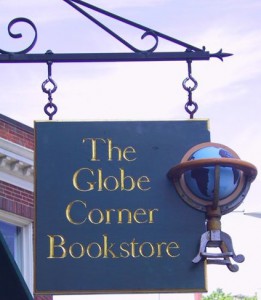 Brookline Booksmith, Brookline, Mass., has bought the rights to Globe Corner Bookstore's trademarks, trade names and website and has formally opened the Globe Corner Travel Annex in its store. With the move, Brookline Booksmith has added more than 2,000 travel maps and plans to continue to expand its already large selection of travel guides as well as increase travel accessories and outdoor recreation products.
Brookline Booksmith, Brookline, Mass., has bought the rights to Globe Corner Bookstore's trademarks, trade names and website and has formally opened the Globe Corner Travel Annex in its store. With the move, Brookline Booksmith has added more than 2,000 travel maps and plans to continue to expand its already large selection of travel guides as well as increase travel accessories and outdoor recreation products.


SHELFAWARENESS.1222.S1.BESTADSWEBINAR.gif)


SHELFAWARENESS.1222.T1.BESTADSWEBINAR.gif)
 R. Todd Noden has joined Books-A-Million as chief financial officer, replacing Brian W. White, who resigned "to pursue other endeavors," the company said. A CPA with an MBA, Noden has 20 years of finance and accounting experience, most recently as CFO of Dobbs Mills and v-p, accounting and financial analysis of Racetrac Petroleum.
R. Todd Noden has joined Books-A-Million as chief financial officer, replacing Brian W. White, who resigned "to pursue other endeavors," the company said. A CPA with an MBA, Noden has 20 years of finance and accounting experience, most recently as CFO of Dobbs Mills and v-p, accounting and financial analysis of Racetrac Petroleum. The new e-reader, he wrote, "offers
The new e-reader, he wrote, "offers 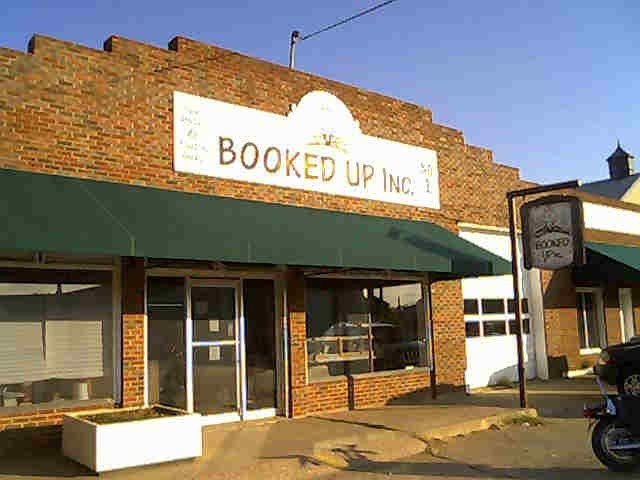



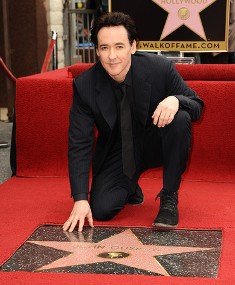 Actor John Cusack was given his
Actor John Cusack was given his 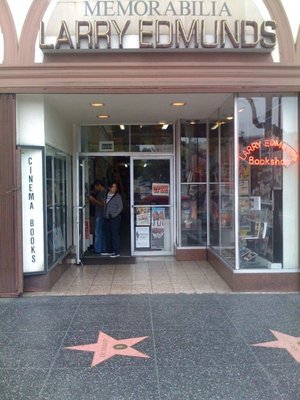 The bookstore's website proclaimed: "Who’s that? CUSACK! right here at Larry Edmunds Bookshop!... It's always nice to welcome a new neighbor to the neighborhood, so we're going to roll out the red carpet. Actually it's the Hollywood Chamber of Commerce, who are awarding the 2,469th star on the Hollywood Walk of Fame to John Cusack right here in front of our humble little bookshop. We would like Mr. Cusack to know we will do our best to make sure his star is swept and shiny for all to enjoy.... and it will be an honor to have him as a neighbor right out front with Mr. Ray Bradbury & Mr. Gene Autry."
The bookstore's website proclaimed: "Who’s that? CUSACK! right here at Larry Edmunds Bookshop!... It's always nice to welcome a new neighbor to the neighborhood, so we're going to roll out the red carpet. Actually it's the Hollywood Chamber of Commerce, who are awarding the 2,469th star on the Hollywood Walk of Fame to John Cusack right here in front of our humble little bookshop. We would like Mr. Cusack to know we will do our best to make sure his star is swept and shiny for all to enjoy.... and it will be an honor to have him as a neighbor right out front with Mr. Ray Bradbury & Mr. Gene Autry."  The real-life Cinderella story of how A Naked Singularity achieved publication is itself the stuff of great fiction. Sergio de la Pava originally self-published his heavyweight novel in 2008. Rather than land silently on the stereotypical scrapheap of vanity press efforts, however, de la Pava's debut began to attract the attention of critics, bloggers and authors such as Lian Hearn (Tales of the Otori). Their rave reviews caught the eye of a publicity manager at University of Chicago Press who read the book and immediately recognized its genius. Now, a wider audience will have the chance to discover this work of amazing breadth and humor.
The real-life Cinderella story of how A Naked Singularity achieved publication is itself the stuff of great fiction. Sergio de la Pava originally self-published his heavyweight novel in 2008. Rather than land silently on the stereotypical scrapheap of vanity press efforts, however, de la Pava's debut began to attract the attention of critics, bloggers and authors such as Lian Hearn (Tales of the Otori). Their rave reviews caught the eye of a publicity manager at University of Chicago Press who read the book and immediately recognized its genius. Now, a wider audience will have the chance to discover this work of amazing breadth and humor.